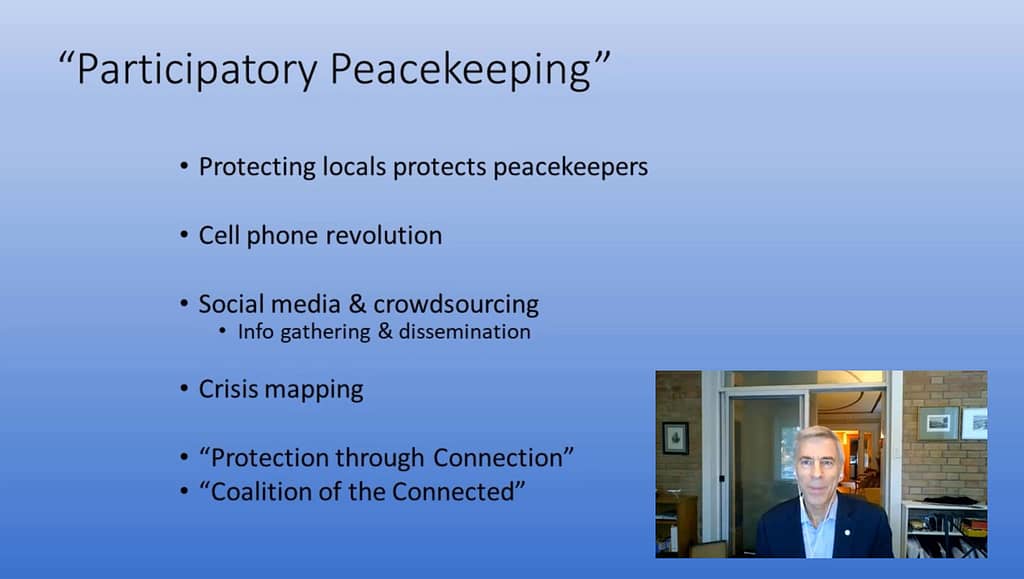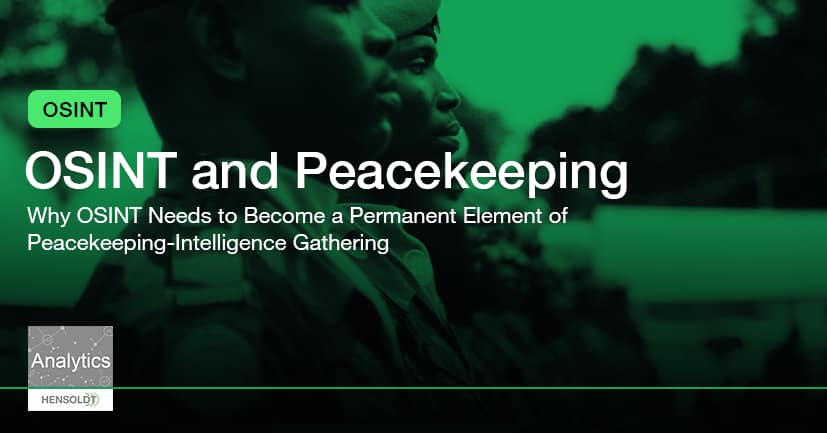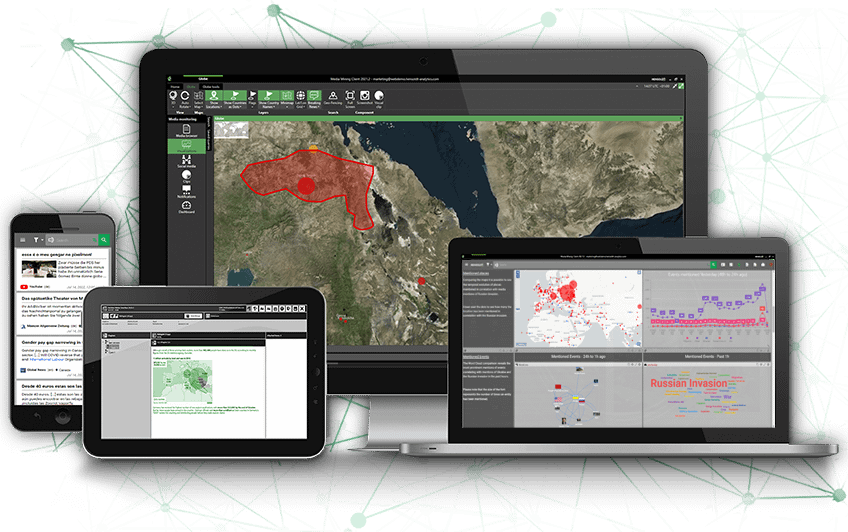This article is based on the topics discussed at the “OSINT and Peacekeeping in Africa” Intelligence Webinar, which aired on the 30th of September, 2021. If you would like to watch the entire webinar, please request the recording here.
On the 30th of September, we hosted the third Intelligence Webinar of 2021, this time focusing on OSINT and peacekeeping. The event follows Hybrid Warfare and OSINT, which aired in May, as well as OSINT and Imagery Intelligence Analysis held in June.
The September webinar was dedicated to the topic of open-source intelligence as a situational awareness tool in complex peacekeeping operations in the African continent. Our team, Anne-Lynn Dudenhöfer (OSINT Analyst & Intel Desk Lead) and Mark Pfeiffer (Chief Visionary Officer), took on the task of exploring the media landscape in Africa and bringing insights on navigating the difficulties peacekeeping missions are facing from the perspective of OSINT practitioners. To support our OSINT analysis, we invited a guest expert – Dr Walter Dorn, Professor of Defence Studies at the Royal Military College of Canada (RMC) and the Canadian Forces College (CFC). Dr Walter Dorn brought to the table his academic and practical background in peace operations and the peacekeeping missions managed by the United Nations. His insights and experience of the challenges posed to international peacekeepers made for a thought-provoking discussion about the urgency of implementing OSINT and technologies enabling OSINT input across the entire lifecycle of modern peacekeeping missions.
Peacekeeping-Intelligence is Inherently Cooperative
Before diving into the complexity of peacekeeping-intelligence, it is crucial to emphasize the difference between peacekeeping-intelligence and military intelligence. According to Dr Walter Dorn, peacekeeping-intelligence (written as one hyphenated word to avoid ambiguity) is “primarily open-source and human intelligence”, and relies on relationship-building with the local population to which the peacekeeping mission is dispatched. The nature of peacekeeping-intelligence gathering is inherently cooperative as it utilises a population-centric approach. Through putting the needs of the community first, the chances of creating a lasting positive impact that extends beyond the peacekeeping missions’ tenure, are much higher.

While the element of establishing contact with the locals is essential to staying aware of the developments on the ground, the means of maintaining the connection have changed over the years. With technology rapidly striding forward, the areas affected by conflict have also become increasingly more connected, which presents not only new opportunities in peacekeeping-intelligence gathering but also new risks to both the civilians as well as peacekeeping personnel. For example, in countries in Africa, the continent with the highest number of ongoing peacekeeping missions at the moment, the changes caused by access to mobiles and smartphones, as well as the novel ways of sharing text, video, and images fast enabled by social media, strengthened the ability of the peacekeepers to protect the local population. At the same time, hostile parties are becoming more adept at utilising technology to further the scope of their attacks, engaging not only in military tactics but also spreading misinformation online aiming to throw their targets off balance.
Here our speakers shared a clear consensus: the peacekeeping operations are falling behind in terms of implementation of new technologies to respond to the changing circumstances in the areas they are supporting. As such, peacekeeping forces and operation centres cannot utilise the vast volumes of open-source data available to them online or monitor signals from local population as they lack the software, training, or awareness of technologies enabling contemporary peacekeeping-intelligence. Modern peacekeeping operations have to be more proactive in not only incorporating more technologically-advanced solutions into the fabric of the missions, but also in using technology to manage OSINT and obtain a clearer understanding of the situation they have entered into.
OSINT as Part of the Peacekeeping Mission’ Toolset
Having set the stage for the necessity of OSINT entering the toolset of peacekeeping missions, Mark Pfeiffer described the roles OSINT plays in all stages of peacekeeping: pre-deployment, deployment, operations phase, close out, and post-exit monitoring.
In the initial planning stage, on-the-ground assessment has to take into account the relationships between involved actors, as well as their potential response and sentiment towards external forces before the mission lands in the conflict area. This pre-emptive analysis using information collected from open sources, as well as unclassified intelligence sources and HUMINT, can often set the tone for the conversations with the locals, as well as the context of these exchanges. The effectiveness of peace operations always depends on the operational support it receives. Therefore, analysing the situation ahead of time allows mission organisers to anticipate disruptions in infrastructure, transport, local supply chains, and resources needed to set up and fulfil mission objectives.

In terms of enabling fast and efficient connections with the locals and putting in place reliable HUMINT networks, peacekeepers have to identify the social and cultural settings as well as the source of tensions ahead of touching ground in conflict areas. As stated by Mark Pfeiffer, peacekeepers have to project a certain amount of force to deter confrontations, while remaining impartial. Even the perception of a lack of impartiality can hurt peacekeeping efforts.

Peacekeeping forces also often have to navigate the delicate tasks of protecting the peacekeeping personnel while working on establishing trust and good relations with the population. Our speakers agreed that in certain environments, high-level of protective measures creates a negative perception and could incite hostility. On the other hand, if there is a perceived vulnerability in the peacekeeping missions’ ability to assure safety of its own personnel the locals might not respond positively to the peace-building efforts. In accordance with this line of argument, Anne-Lynn Dudenhöfer mentioned that a thorough sentiment analysis as well as gleaning information from open-sources can fill in the blanks in pre-deployment briefings to help shape the subsequent actions.
It’s important to add that especially when it comes to perceptions and influencing local population, the practice of media manipulation and misinformation is seen as one of the new practices successfully adopted by hostile fractions, as well as those opposing foreign involvement. Thus, understanding the forces that may negatively affect or attempt to alter perception of the peacekeeping forces should become part of peacekeeping-intelligence efforts.
Find out More about OSINT and Peacekeeping in Africa in Our On-Demand Webinar
On the 30th of September, HENSOLDT Analytics team explored the topic of OSINT Intelligence as a situational awareness tool in complex peacekeeping operations in the African continent in a dedicated virtual event.
Mark Pfeiffer, Chief Visionary Officer at HENSOLDT Analytics, took a look at the use of OSINT in preparing and supporting such missions as an additional sensor; one which allows an increased situational awareness and understanding meant to protect and support the missions’ objectives as well as all of those involved.
Our OSINT Analyst, Anne-Lynn Dudenhöfer, shared her insights on the topic of “Protecting Peacekeepers & Civilians: OSINT for Improved Situational Awareness“. In particular, she provided a comprehensive analysis of the added value that the United Nations Support Mission in Libya could gain from open-source information and intelligence with regards to the upcoming Libyan elections.
Our presenters was joined by a guest expert – Dr Walter Dorn, Professor of Defence Studies at the Royal Military College of Canada (RMC) and the Canadian Forces College (CFC), who specializes in arms control, peace operations, just war theory, international criminal law, treaty verification and enforcement, and the United Nations.
On-Demand Intelligence Webinar: OSINT and Peacekeeping in Africa
Banner image: “International Day of United Nations Peacekeepers” by MONUSCO is licensed under CC BY-SA 2.0.





